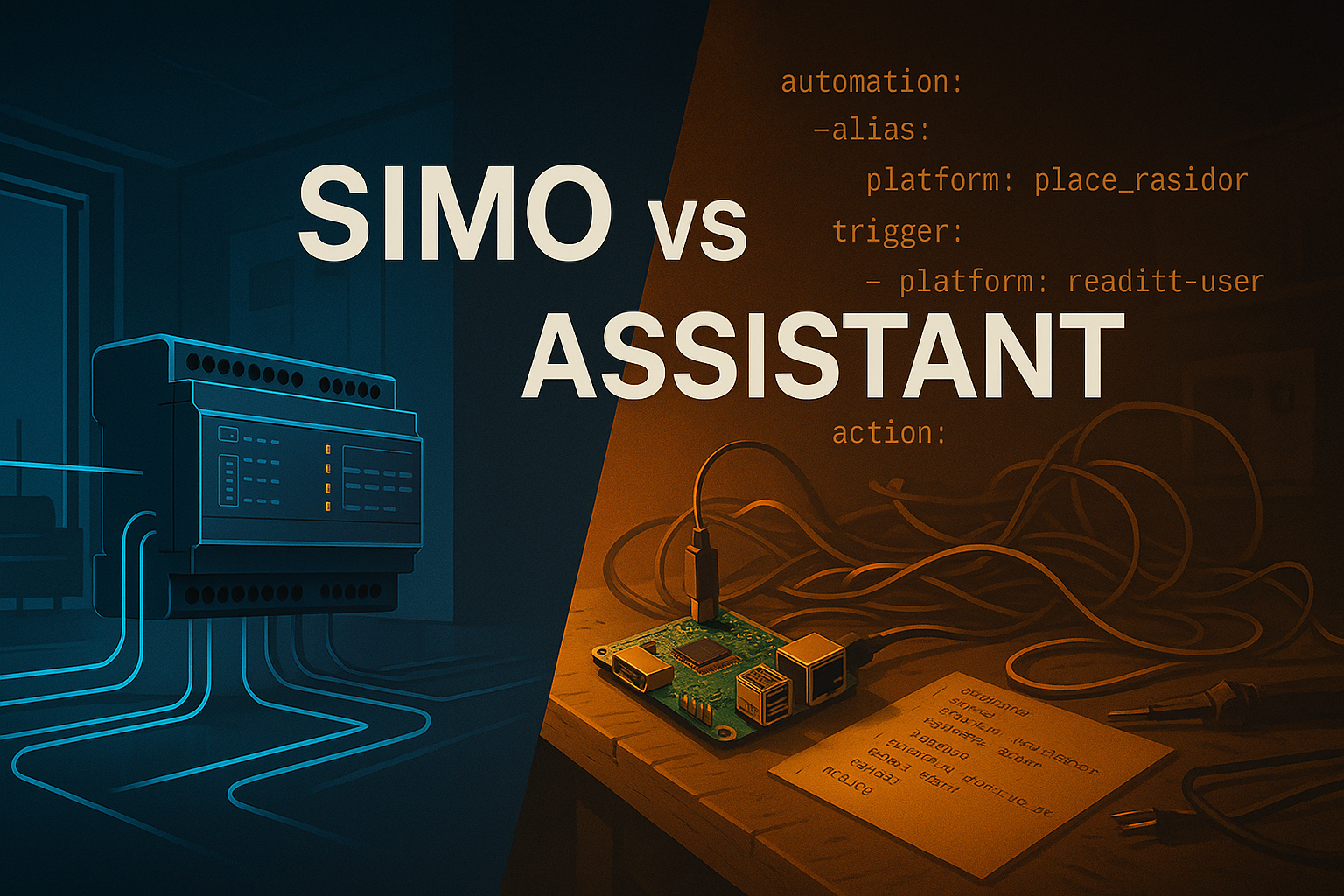Professional Home Assistant Alternative
Home Assistant transformed hobbyist home-automation by giving do-it-yourselfers a free, Python-based platform with thousands of community integrations. Yet as projects scale from “weekend tinkering” to wired, professionally installed systems, its YAML-heavy workflows, Docker sandboxing, and device-centric topology expose pain points for installers who need rapid deployment, bullet-proof reliability, and easy maintenance. SIMO.io steps in exactly there: a DIN-rail, plug-and-play hardware family tied to a wired-first, open-source hub that still offers root-level Linux access, granular user permissions, and even AI-assisted Python scripting. What follows unpacks why those architectural choices matter—and how SIMO.io closes the gap between hobbyist flexibility and enterprise-grade dependability.

1. A brief history of open-source smart-home platforms
1.1 From clunky pioneers to YAML heaven
Before 2015, projects such as OpenHAB and Domoticz dominated FOSS automation. They offered powerful rule engines but asked users to edit XML or proprietary DSLs, pair Z-Wave dongles manually, and run Java on underpowered single-board computers—high hurdles for non-developers. 🠚 Many casual homeowners gave up or chose closed ecosystems like Control4 instead.
1.2 Home Assistant’s meteoric rise
Home Assistant (HA) arrived in 2013 with two crowd-pleasers: Python 3 and flat-file YAML configs, which felt cleaner than Java properties or XML. Within ten years the community built 2 500+ core and custom integrations—covering Zigbee, Z-Wave, Matter, cloud APIs and esoteric devices alike. Local processing, no subscription and privacy by design further super-charged adoption.
2. Where Home Assistant shines—and where it stalls for professionals
2.1 Strengths every tinkerer loves
-
Breadth of integrations. Everything from Philips Hue to Tesla Powerwall is one click—or one YAML stanza—away.
-
Active community. Forums, blueprints and HACS repos publish new automations daily, lowering experimentation cost.
-
Privacy & local control. No forced cloud, optional Nabu Casa subscription only for remote access and voice.
2.2 The YAML ceiling
As estates grow beyond a few smart bulbs, YAML becomes fragile:
-
Novices routinely break indentation and cripple the system—“I tried configuration.yaml and messed it up!” laments a newcomer on the HA forum.
-
Troubleshooting docs warn of idiosyncrasies, duplicate keys and upgrade-breaking schema changes.
-
Even veterans debate “YAML vs UI” because advanced logic still demands hand-editing.
2.3 Maintenance headaches in real homes
-
Each Z-Wave or Zigbee node has a unique network ID; replace a failed dimmer and you must re-pair, rename entities and patch automations—tedious in a 100-device villa.
-
Gaining root access for deep fixes involves bespoke add-ons or USB key tricks and is discouraged by default.
-
Professional installers often post asking whether HA is “enterprise ready,” admitting reluctance to support it commercially.
3. SIMO.io—professional by design
SIMO.io was engineered from day one for electricians and integrators who deliver projects under SLA, not hobby time.
3.1 Plug-and-play DIN-rail hardware
The Game-Changer board packs 38 universal I/O plus PoE and ESP32 brains, slots into a standard DIN rail. Swappable modules (Relay, AC/DC dimmer, DALI, I²C, Binary Input, etc.) click into place with spring terminals—no flashing firmware or soldering.
Result: An installer arrives with pre-terminated cables, plugs in modules, scans a QR code in the SIMO mobile app, and walks the client through scenes the same afternoon—no YAML, no Docker exec, no dependency hell.
3.2 Wired-first network = rock-solid reliability
Wireless devices are “shameful” for mission-critical systems! A single Cat 6 cable delivers power and Ethernet to every controller, eliminating RF congestion, dead-battery sensors, and hack-prone Wi-Fi light switches. Wired topologies have long been prized for immunity to radio interference and guaranteed latency.
Bonus feature - hooking entire system on to a UPS unit provides continuous operation during power outages.
Yet SIMO.io remains pragmatic: Game-Changer boards can ride WiFi if wire is no longer an option, even Zwave or WiFi sensors can join the network, but we try to avoid that at all cost.
3.3 Hot-swap resilience
SIMO.io is easy to maintain. If any of Game-Changer modules ever goes bad, you simply replace the module, no configuration or pairing needs to be done. If Game-Changer board itself goes bad, simply replace the board itself and make the easy adjustment via SIMO.io mobile app.
All automations and related objects stay in place, no need to reprogram anything. Now compare that to any other system where system components have they'r own unique addresses/id's, if you ever need to replace failed component, you also have to repair it to the system and figure out what role it was playing, so that you could properly fix everything else that was related to it. That's a nightmare on it's own!
3.4 Role-based access & onboarding
Inviting a user is as simple as scanning a barcode; back-office installers retain superuser credentials, owners get day-to-day control, and babysitters can be limited to lights only. Granular RBAC is rare in DIY hubs but expected in commercial BMS.
3.5 Superuser paradise—full Linux, anywhere
Superusers get's remote access to SIMO.io smart hub via web admin interface, which opens up a lot more technical elements of the system. Superusers can also SSH directly in to SIMO.io smart hub with root privileges and take full control of Ubuntu based linux smart home hub to install custom packages and perform other serious changes, all from anywhere around the world.
This really helps when you are in smart home business. A lot of smart home configuration work can be done completely remotely.
3.6 AI-assisted Python scripting
SIMO.io keeps automation logic in plain Python, not YAML. That opens the full standard library plus pip to power users. To help non-programmers, the hub ships with an integrated ChatGPT-style assistant that generates ready-to-run scripts from natural language (“When my EV reaches 80 %, pre-heat the sauna”). While HA also has third-party ChatGPT add-ons, they are optional extras, not core workflow.
4. Head-to-head comparison
| Dimension |
Home Assistant |
SIMO.io |
| Target audience |
Hobbyists, tinkerers, privacy advocates |
Professional installers, large residences, commercial |
| Primary config |
YAML files + UI forms |
Mobile app UI; optional Python scripts |
| Hardware model |
Bring-your-own (Raspberry Pi, NUC, countless radios) |
Curated DIN-rail controllers & hub |
| Network philosophy |
Wi-Fi / Zigbee / Z-Wave first, Ethernet optional |
Wired PoE backbone, wireless secondary |
| Integration count |
2 500+ community integrations |
Smaller catalogue, focus on robust protocols & open APIs |
| Module replacement |
Re-pair each node, fix entity IDs |
Hot-swap, no automation changes |
| Root access |
Possible but indirect via add-ons |
SSH root available out-of-box |
| User roles |
Basic administrator/user split |
Fine-grained RBAC, QR onboarding |
| AI tooling |
Community plug-ins |
Built-in assistant writes Python scripts |
5. Why wired-first matters in 2025 and beyond
The consumer IoT boom pushed Wi-Fi bulbs and BLE sensors into every hardware store, but professional-grade automation still prizes deterministic latency:
-
Reliability. Shielded twisted pair laughs at microwave ovens and thick concrete where Zigbee mesh collapses.
-
Security. No over-the-air pairing codes to sniff; PoE switches sit behind a firewall.
-
Lifecycle. Ethernet cabling outlasts trendy radio stacks, future-proofing investments.
Real estate developers increasingly hard-wire motion sensors, HVAC dampers and KNX lighting because call-backs to fix flaky Wi-Fi cost more than copper. SIMO.io rides that trend while permitting wireless for legacy add-ons.
6. The economics for installers
-
Faster commissioning: QR onboarding + pre-terminated patch panels slash labour hours.
-
Remote ops: Root SSH and web admin let technicians patch Python automations from the office instead of rolling a van.
-
Reduced truck rolls: Swapping a €10 relay module is faster than re-including a Zigbee device and rewriting scenes.
-
Up-sell opportunities: Python/AI engine lets consultants charge for bespoke logic (e.g., energy price optimisation) without hitting YAML walls.
7. Conclusion
Home Assistant remains a brilliant sandbox—perfect for a Raspberry Pi, a 3D-printed case and a weekend of tinkering. But once projects demand SLA-level uptime, structured hand-off to non-technical occupants, and predictable maintenance budgets, its DIY roots show. SIMO.io answers that by fusing open-source transparency with enterprise-grade hardware, wired networking, RBAC, hot-swap modules, and AI-assisted scripting. The result is a platform that lets professionals deliver smart homes that feel like appliances, not science projects—while still giving power users root access when they want to dive deeper.
In short: If you are wiring a three-phase DIN cabinet anyway, choose the controller family that was designed to live there. That is SIMO.io.
Related pages
Below you’ll discover the ten pillars that turn SIMO.io into the most trustworthy—and delightfully responsive—smart-home platform available. We’ll also show how each pillar eclipses typical DIY hubs and mass-market cloud gadgets.
SIMO.io is the most secure, modular, easy to install and maintain smart home system ever created!
This is the most essential Wiki page of SIMO.io. Building enterprise level smart home automations with SIMO.io is easy, quick and fun. All you need to know to get you started from scratch is right here in this tutorial!


